Dead Fuel Moisture Content (DFMC) Estimation Using MODIS and Meteorological Data: The Case of Greece
Abstract
:1. Introduction
2. Materials and Methods
2.1. Study Areas
2.2. Reference Datasets
2.3. Satellite Imagery
2.4. Meteorological Data
2.5. Dead Fine Fuel Moisture Content—DFMC
2.6. Exploratory Data Analysis
2.7. Validation Process
3. Results
3.1. Satellite-Based DFMC Maps
3.2. Weather Station-Based DFMC Maps
3.3. Validation and Exploratory Data Analysis Results
3.3.1. Exploratory Data Analysis Results
3.3.2. Validation of the Satellite—Based Variable Water Vapour-Pressure Deficit D
3.3.3. Validation of the Satellite-Based DFMC
4. Discussion
4.1. Performance of the DFMC Model
4.2. Comparison of the Two Approaches Applied to Estimate DFMC
5. Conclusions
Author Contributions
Funding
Data Availability Statement
Acknowledgments
Conflicts of Interest
References
- Vallejo Calzada, V.R.; Faivre, N.; Cardoso Castro Rego, F.M.; Moreno Rodríguez, J.M.; Xanthopoulos, G. Forest Fires. Sparking Firesmart Policies in the EU. 2018. Available online: https://ec.europa.eu/info/sites/default/files/181116_booklet-forest-fire-hd.pdf (accessed on 3 June 2021).
- Nolan, R.H.; Boer, M.M.; Resco de Dios, V.; Caccamo, G.; Bradstock, R.A. Large-scale, dynamic transformations in fuel moisture drive wildfire activity across southeastern Australia. Geophys. Res. Lett. 2016, 43, 4229–4238. [Google Scholar] [CrossRef] [Green Version]
- Ramo, R.; Roteta, E.; Bistinas, I.; Van Wees, D.; Bastarrika, A.; Chuvieco, E.; Van der Werf, G.R. African burned area and fire carbon emissions are strongly impacted by small fires undetected by coarse resolution satellite data. Proc. Natl. Acad. Sci. USA 2021, 118, e2011160118. [Google Scholar] [CrossRef] [PubMed]
- Chuvieco, E.; Aguado, I.; Yebra, M.; Nieto, H.; Salas, J.; Martín, M.P.; Vilar, L.; Martínez, J.; Martín, S.; Ibarra, P.; et al. Development of a framework for fire risk assessment using remote sensing and geographic information system technologies. Ecol. Model. 2010, 221, 46–58. [Google Scholar] [CrossRef]
- Fan, C.; He, B. A Physics-Guided Deep Learning Model for 10-h Dead Fuel Moisture Content Estimation. Forests 2021, 12, 933. [Google Scholar] [CrossRef]
- San-Miguel-Ayanz, J.; Costa, H.; de Rigo, D.; Libertá, G.; Vivancos, T.A.; Durrant, T.; Nuijten, D.; Loffler, P.; Moore, P. Basic criteria to assess wildfire risk at the pan-European level. In JRC Technical Reports; EUR 29500 EN; Publications Office of the European Union: Luxembourg, 2018. [Google Scholar]
- Morgan, P.; Hardy, C.C.; Swetnam, T.W.; Rollins, M.G.; Long, D.G. Mapping fire regimes across time and space: Understanding coarse and fine-scale fire patterns. Int. J. Wildland Fire 2001, 10, 329–342. [Google Scholar] [CrossRef] [Green Version]
- Chuvieco, E.; Aguado, I.; Salas, J.; García, M.; Yebra, M.; Oliva, P. Satellite remote sensing contributions to wildland fire science and management. Curr. For. Rep. 2020, 6, 81–96. [Google Scholar] [CrossRef]
- Danson, F.M.; Bowyer, P. Estimating live fuel moisture content from remotely sensed reflectance. Remote Sens. Environ. 2004, 92, 309–321. [Google Scholar] [CrossRef]
- Nolan, R.H.; Blackman, C.J.; de Dios, V.R.; Choat, B.; Medlyn, B.E.; Li, X.; Bradstock, R.A.; Boer, M.M. Linking forest flammability and plant vulnerability to drought. Forests 2020, 11, 779. [Google Scholar] [CrossRef]
- Boer, M.M.; Nolan, R.H.; De Dios, V.R.; Clarke, H.; Price, O.F.; Bradstock, R.A. Changing weather extremes call for early warning of potential for catastrophic fire. Earths Future 2017, 5, 1196–1202. [Google Scholar] [CrossRef]
- Bradstock, R.A.; Nolan, R.; Collins, L.; Resco de Dios, V.; Clarke, H.; Jenkins, M.E.; Kenny, B.; Boer, M.M. A broader perspective on the causes and consequences of eastern Australia’s 2019-2020 season of mega-fires: A response to Adams et al. Glob. Chang. Biol. 2020, 26, e8–e9. [Google Scholar] [CrossRef]
- Argañaraz, J.P.; Landi, M.A.; Scavuzzo, C.M.; Bellis, L.M. Determining fuel moisture thresholds to assess wildfire hazard: A contribution to an operational early warning system. PLoS ONE 2018, 13, e0204889. [Google Scholar] [CrossRef] [Green Version]
- Yebra, M.; Quan, X.; Riaño, D.; Larraondo, P.R.; van Dijk, A.I.; Cary, G.J. A fuel moisture content and flammability monitoring methodology for continental Australia based on optical remote sensing. Remote Sens. Environ. 2018, 212, 260–272. [Google Scholar] [CrossRef]
- Wang, L.; Quan, X.; He, B.; Yebra, M.; Xing, M.; Liu, X. Assessment of the dual polarimetric sentinel-1A data for forest fuel moisture content estimation. Remote Sens. 2019, 11, 1568. [Google Scholar] [CrossRef] [Green Version]
- Matthews, S. A process-based model of fine fuel moisture. Int. J. Wildland Fire 2006, 15, 155–168. [Google Scholar] [CrossRef]
- Viney, N.R. A review of fine fuel moisture modelling. Int. J. Wildland Fire 1991, 1, 215–234. [Google Scholar] [CrossRef]
- Liu, Y. Responses of dead forest fuel moisture to climate change. Ecohydrology 2017, 10, e1760. [Google Scholar] [CrossRef]
- Marino, E.; Yebra, M.; Guillén-Climent, M.; Algeet, N.; Tomé, J.L.; Madrigal, J.; Guijarro, M.; Hernando, C. Investigating Live Fuel Moisture Content Estimation in Fire-Prone Shrubland from Remote Sensing Using Empirical Modelling and RTM Simulations. Remote Sens. 2020, 12, 2251. [Google Scholar] [CrossRef]
- Yebra, M.; Dennison, P.E.; Chuvieco, E.; Riano, D.; Zylstra, P.; Hunt Jr, E.R.; Danson, F.M.; Qi, Y.; Jurdao, S. A global review of remote sensing of live fuel moisture content for fire danger assessment: Moving towards operational products. Remote Sens. Environ. 2013, 136, 455–468. [Google Scholar] [CrossRef]
- Camia, A.; Leblon, B.; Cruz, M.; Carlson, J.; Aguado, I. Methods used to estimate moisture content of dead wildland fuels. In Wildland Fire Danger Estimation and Mapping: The Role of Remote Sensing Data; World Scientific: Singapore, 2003; pp. 91–117. [Google Scholar]
- Caccamo, G.; Chisholm, L.; Bradstock, R.; Puotinen, M.L.; Pippen, B. Monitoring live fuel moisture content of heathland, shrubland and sclerophyll forest in south-eastern Australia using MODIS data. Int. J. Wildland Fire 2012, 21, 257–269. [Google Scholar] [CrossRef]
- Fan, L.; Wigneron, J.-P.; Xiao, Q.; Al-Yaari, A.; Wen, J.; Martin-StPaul, N.; Dupuy, J.-L.; Pimont, F.; Al Bitar, A.; Fernandez-Moran, R.; et al. Evaluation of microwave remote sensing for monitoring live fuel moisture content in the Mediterranean region. Remote Sens. Environ. 2018, 205, 210–223. [Google Scholar] [CrossRef]
- Krueger, E.S.; Ochsner, T.E.; Carlson, J.; Engle, D.M.; Twidwell, D.; Fuhlendorf, S.D. Concurrent and antecedent soil moisture relate positively or negatively to probability of large wildfires depending on season. Int. J. Wildland Fire 2016, 25, 657–668. [Google Scholar] [CrossRef]
- Kidnie, S.; Cruz, M.G.; Gould, J.; Nichols, D.; Anderson, W.; Bessell, R. Effects of curing on grassfires: I. Fuel dynamics in a senescing grassland. Int. J. Wildland Fire 2015, 24, 828–837. [Google Scholar] [CrossRef]
- García, M.; Riaño, D.; Yebra, M.; Salas, J.; Cardil, A.; Monedero, S.; Ramirez, J.; Martín, M.P.; Vilar, L.; Gajardo, J.; et al. A Live Fuel Moisture Content Product from Landsat TM Satellite Time Series for Implementation in Fire Behavior Models. Remote Sens. 2020, 12, 1714. [Google Scholar] [CrossRef]
- Dimitrakopoulos, A.; Bemmerzouk, A. Predicting live herbaceous moisture content from a seasonal drought index. Int. J. Biometeorol. 2003, 47, 73–79. [Google Scholar] [CrossRef]
- Qi, Y.; Dennison, P.E.; Spencer, J.; Riaño, D. Monitoring live fuel moisture using soil moisture and remote sensing proxies. Fire Ecol. 2012, 8, 71–87. [Google Scholar] [CrossRef]
- Chuvieco, E.; Aguado, I.; Dimitrakopoulos, A.P. Conversion of fuel moisture content values to ignition potential for integrated fire danger assessment. Can. J. For. Res. 2004, 34, 2284–2293. [Google Scholar] [CrossRef]
- Yebra, M.; Scortechini, G.; Badi, A.; Beget, M.E.; Boer, M.M.; Bradstock, R.; Chuvieco, E.; Danson, F.M.; Dennison, P.; de Dios, V.R.; et al. Globe-LFMC, a global plant water status database for vegetation ecophysiology and wildfire applications. Sci. Data 2019, 6, 155. [Google Scholar] [CrossRef] [Green Version]
- Sharples, J.J.; Lewis, S.C.; Perkins-Kirkpatrick, S.E. Modulating influence of drought on the synergy between heatwaves and dead fine fuel moisture content of bushfire fuels in the Southeast Australian region. Weather Clim. Extrem. 2021, 31, 100300. [Google Scholar] [CrossRef]
- Marino, E.; Madrigal, J.; Guijarro, M.; Hernando, C.; Díez, C.; Fernández, C. Flammability descriptors of fine dead fuels resulting from two mechanical treatments in shrubland: A comparative laboratory study. Int. J. Wildland Fire 2010, 19, 314–324. [Google Scholar] [CrossRef]
- Burton, J.; Cawson, J.; Noske, P.; Sheridan, G. Shifting states, altered fates: Divergent fuel moisture responses after high frequency wildfire in an obligate seeder eucalypt forest. Forests 2019, 10, 436. [Google Scholar] [CrossRef] [Green Version]
- Gill, A.M.; Zylstra, P. Flammability of Australian forests. Aust. For. 2005, 68, 87–93. [Google Scholar] [CrossRef] [Green Version]
- de Dios, V.R.; Fellows, A.W.; Nolan, R.H.; Boer, M.M.; Bradstock, R.A.; Domingo, F.; Goulden, M.L. A semi-mechanistic model for predicting the moisture content of fine litter. Agric. For. Meteorol. 2015, 203, 64–73. [Google Scholar] [CrossRef] [Green Version]
- Lee, H.; Won, M.; Yoon, S.; Jang, K. Estimation of 10-Hour Fuel Moisture Content Using Meteorological Data: A Model Inter-Comparison Study. Forests 2020, 11, 982. [Google Scholar] [CrossRef]
- Bakšić, N.; Bakšić, D.; Jazbec, A. Hourly fine fuel moisture model for Pinus halepensis (Mill.) litter. Agric. For. Meteorol. 2017, 243, 93–99. [Google Scholar] [CrossRef]
- Pickering, B.J.; Duff, T.J.; Baillie, C.; Cawson, J.G. Darker, cooler, wetter: Forest understories influence surface fuel moisture. Agric. For. Meteorol. 2021, 300, 108311. [Google Scholar] [CrossRef]
- Rakhmatulina, E.; Stephens, S.; Thompson, S. Soil moisture influences on Sierra Nevada dead fuel moisture content and fire risks. For. Ecol. Manag. 2021, 496, 119379. [Google Scholar] [CrossRef]
- Kane, J.M. Stand conditions alter seasonal microclimate and dead fuel moisture in a Northwestern California oak woodland. Agric. For. Meteorol. 2021, 308–309, 108602. [Google Scholar] [CrossRef]
- Bovill, W.; Hawthorne, S.; Radic, J.; Baillie, C.; Ashton, A.; Noske, P.; Lane, P.; Sheridan, G. Effectiveness of automated fuelsticks for predicting the moisture content of dead fuels in Eucalyptus forests. In Proceedings of the 21st International Congress on Modelling and Simulation, Gold Coast, Australia, 29 November–4 December 2015; Volume 29, pp. 201–207. [Google Scholar]
- Hiers, J.K.; Stauhammer, C.L.; O’Brien, J.J.; Gholz, H.L.; Martin, T.A.; Hom, J.; Starr, G. Fine dead fuel moisture shows complex lagged responses to environmental conditions in a saw palmetto (Serenoa repens) flatwoods. Agric. For. Meteorol. 2019, 266, 20–28. [Google Scholar] [CrossRef]
- Masinda, M.M.; Li, F.; Liu, Q.; Sun, L.; Hu, T. Prediction model of moisture content of dead fine fuel in forest plantations on Maoer Mountain, Northeast China. J. For. Res. 2021, 32, 2023–2035. [Google Scholar] [CrossRef]
- Cawson, J.G.; Nyman, P.; Schunk, C.; Sheridan, G.J.; Duff, T.J.; Gibos, K.; Bovill, W.D.; Conedera, M.; Pezzatti, G.B.; Menzel, A. Corrigendum to: Estimation of surface dead fine fuel moisture using automated fuel moisture sticks across a range of forests worldwide. Int. J. Wildland Fire 2020, 29, 560. [Google Scholar] [CrossRef]
- Aguado, I.; Chuvieco, E.; Boren, R.; Nieto, H. Estimation of dead fuel moisture content from meteorological data in Mediterranean areas. Applications in fire danger assessment. Int. J. Wildland Fire 2007, 16, 390–397. [Google Scholar] [CrossRef]
- Nolan, R.H.; de Dios, V.R.; Boer, M.M.; Caccamo, G.; Goulden, M.L.; Bradstock, R.A. Predicting dead fine fuel moisture at regional scales using vapour pressure deficit from MODIS and gridded weather data. Remote Sens. Environ. 2016, 174, 100–108. [Google Scholar] [CrossRef] [Green Version]
- Nieto, H.; Aguado, I.; Chuvieco, E.; Sandholt, I. Dead fuel moisture estimation with MSG–SEVIRI data. Retrieval of meteorological data for the calculation of the equilibrium moisture content. Agric. For. Meteorol. 2010, 150, 861–870. [Google Scholar] [CrossRef] [Green Version]
- Hashimoto, H.; Dungan, J.L.; White, M.A.; Yang, F.; Michaelis, A.R.; Running, S.W.; Nemani, R.R. Satellite-based estimation of surface vapor pressure deficits using MODIS land surface temperature data. Remote Sens. Environ. 2008, 112, 142–155. [Google Scholar] [CrossRef]
- Stow, D.; Niphadkar, M.; Kaiser, J. Time series of chaparral live fuel moisture maps derived from MODIS satellite data. Int. J. Wildland Fire 2006, 15, 347–360. [Google Scholar] [CrossRef]
- Peterson, S.H.; Roberts, D.A.; Dennison, P.E. Mapping live fuel moisture with MODIS data: A multiple regression approach. Remote Sens. Environ. 2008, 112, 4272–4284. [Google Scholar] [CrossRef]
- Zormpas, K.; Vasilakos, C.; Athanasis, N.; Soulakellis, N.; Kalabokidis, K. Dead fuel moisture content estimation using remote sensing. Eur. J. Geogr. 2017, 8, 17–32. [Google Scholar]
- Keetch, J.J.; Byram, G.M. A Drought Index for Forest Fire Control; Research Paper SE-38; US Department of Agriculture, Forest Service, Southeastern Forest Experiment Station: Asheville, NC, USA, 1968; p. 35.
- Van Wagner, C.E.; Forest, P. Development and Structure of the Canadian Forest Fireweather Index System. Can. For. Serv. Forestry Tech. Rep. 1987, 35, 37. [Google Scholar]
- McArthur, A.G. Weather and Grassland Fire Behaviour; Forestry and Timber Bureau, Department of National Development, Commonwealth: Canberra, Australia, 1966.
- McArthur, A.G. Fire Behaviour in Eucalypt Forests; Commonwealth of Austalia Forest and Timber Bureau: Canberra, Australia, 1967; Available online: https://vgls.sdp.sirsidynix.net.au/client/search/asset/1299701/0 (accessed on 30 June 2021).
- Sharples, J.J.; McRae, R.H.; Weber, R.; Gill, A.M. A simple index for assessing fuel moisture content. Environ. Model. Softw. 2009, 24, 637–646. [Google Scholar] [CrossRef]
- Lagouvardos, K.; Kotroni, V.; Giannaros, T.M.; Dafis, S. Meteorological conditions conducive to the rapid spread of the deadly wildfire in eastern Attica, Greece. Bull. Am. Meteorol. Soc. 2019, 100, 2137–2145. [Google Scholar] [CrossRef]
- Lu, L.; Zhang, T.; Wang, T.; Zhou, X. Evaluation of collection-6 MODIS land surface temperature product using multi-year ground measurements in an arid area of Northwest China. Remote Sens. 2018, 10, 1852. [Google Scholar] [CrossRef] [Green Version]
- Lagouvardos, K.; Kotroni, V.; Bezes, A.; Koletsis, I.; Kopania, T.; Lykoudis, S.; Mazarakis, N.; Papagiannaki, K.; Vougioukas, S. The automatic weather stations NOANN network of the National Observatory of Athens: Operation and database. Geosci. Data J. 2017, 4, 4–16. [Google Scholar] [CrossRef]
- Berndt, C.; Haberlandt, U. Spatial interpolation of climate variables in Northern Germany—Influence of temporal resolution and network density. J. Hydrol. Reg. Stud. 2018, 15, 184–202. [Google Scholar] [CrossRef]
- Nash, C.; Johnson, E. Synoptic climatology of lightning-caused forest fires in subalpine and boreal forests. Can. J. For. Res. 1996, 26, 1859–1874. [Google Scholar] [CrossRef]
- Wan, Z.; Zhang, Y.; Zhang, Q.; Li, Z. Validation of the land-surface temperature products retrieved from Terra Moderate Resolution Imaging Spectroradiometer data. Remote Sens. Environ. 2002, 83, 163–180. [Google Scholar] [CrossRef]
- Matthews, S.; McCaw, W.; Neal, J.; Smith, R. Testing a process-based fine fuel moisture model in two forest types. Can. J. For. Res. 2006, 37, 23–35. [Google Scholar] [CrossRef]
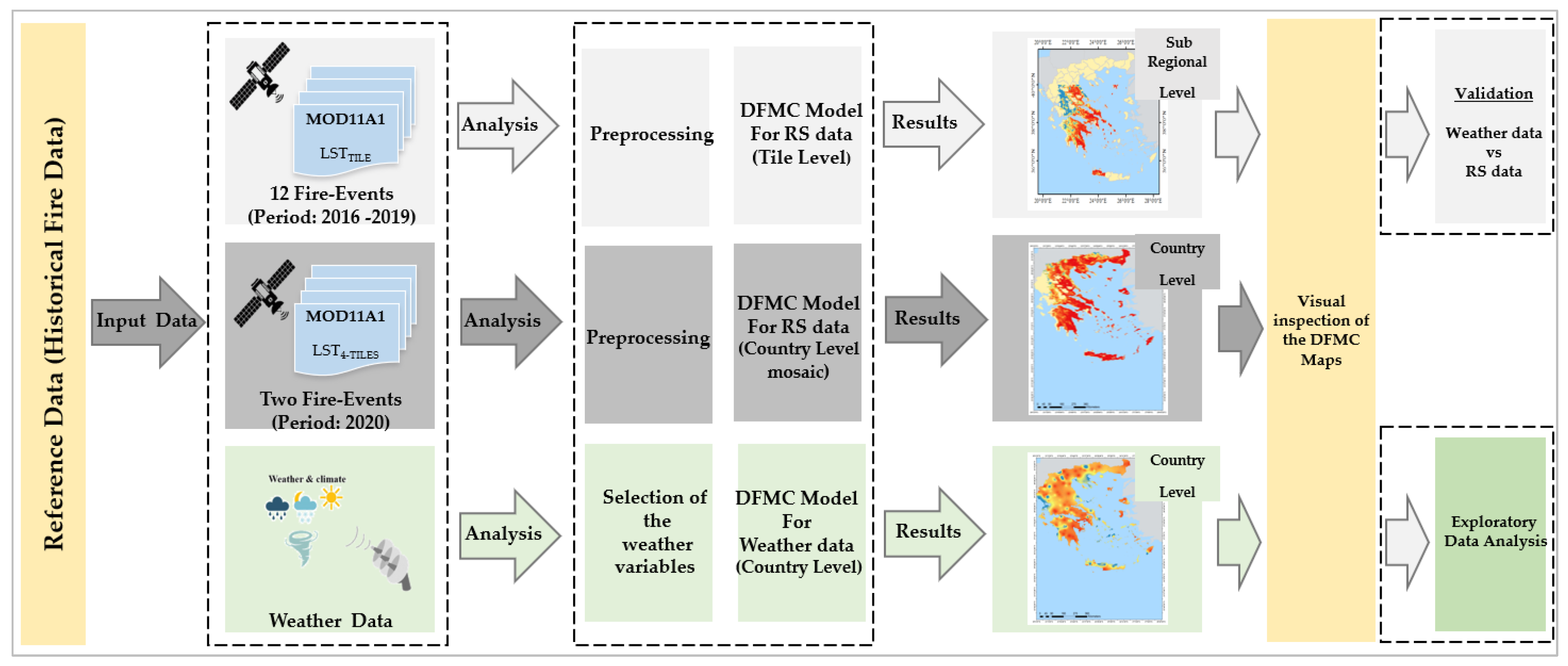

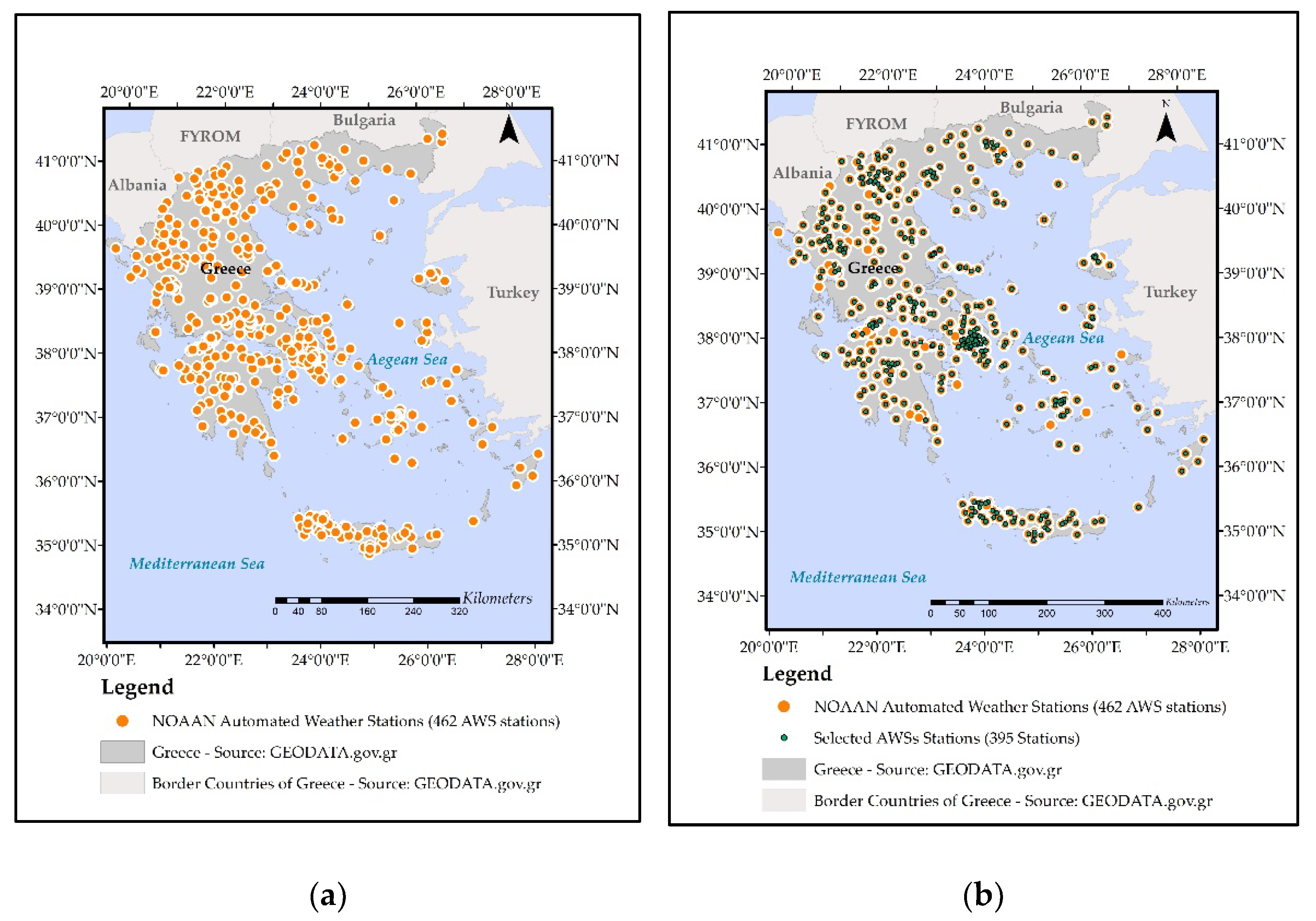

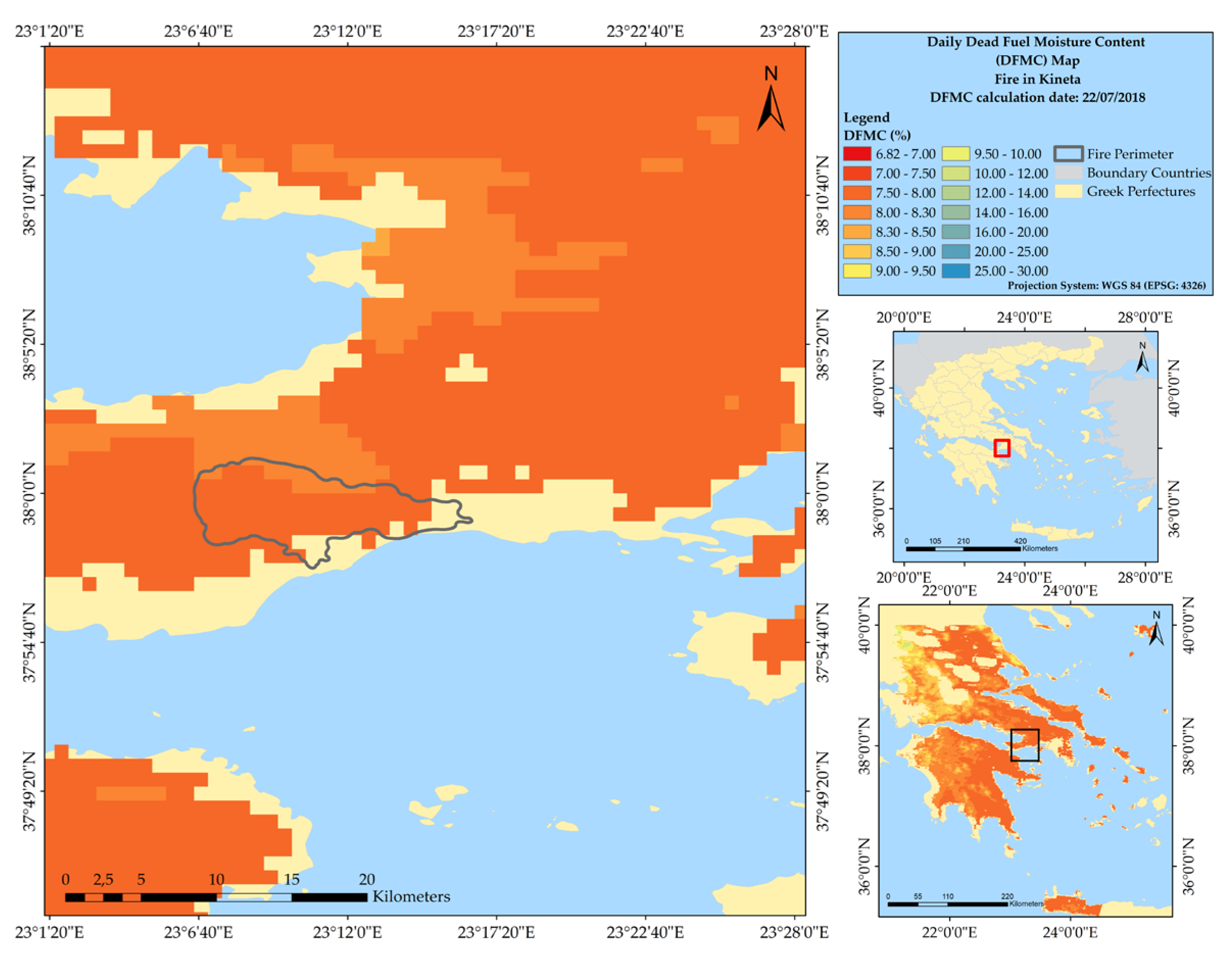


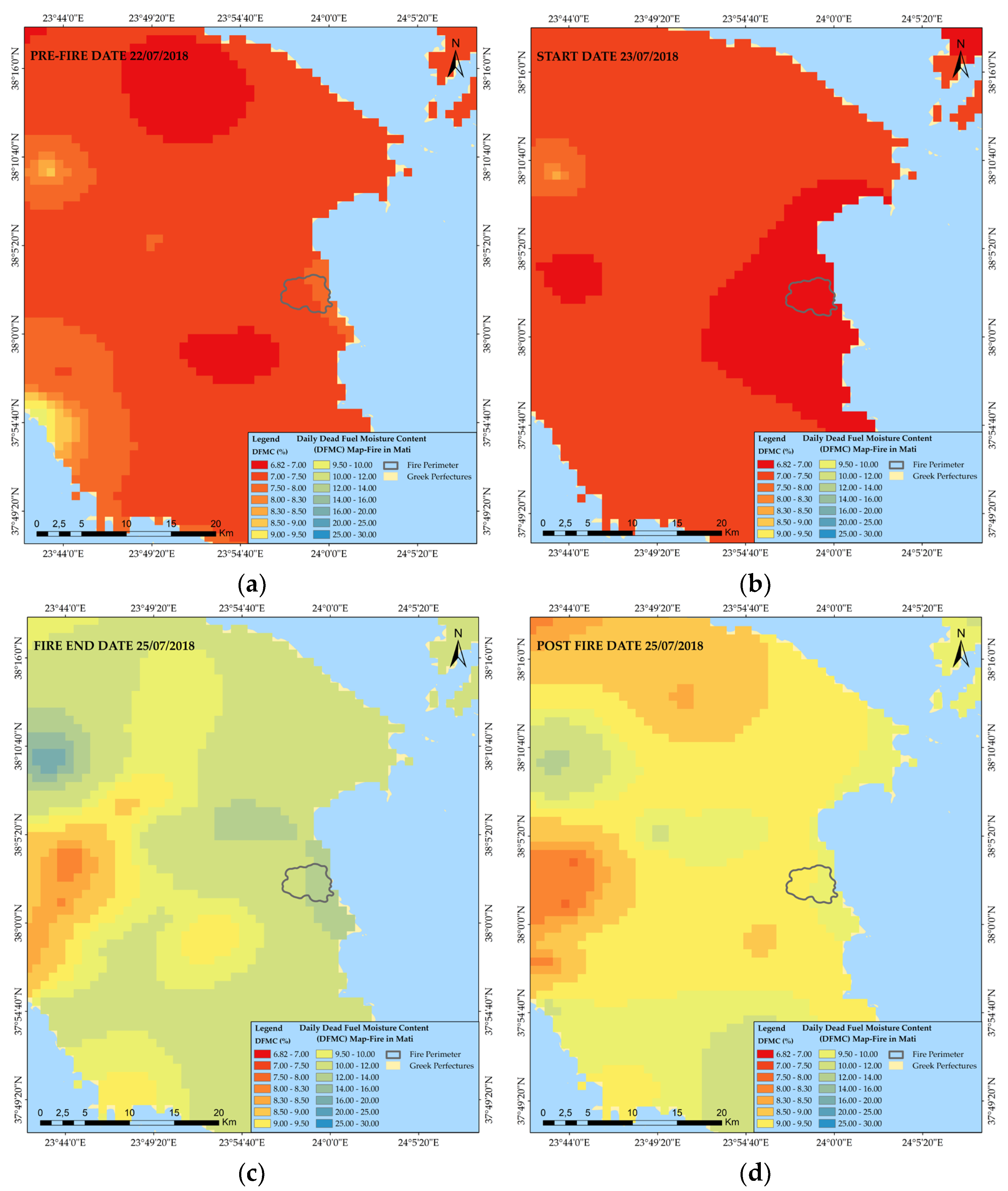
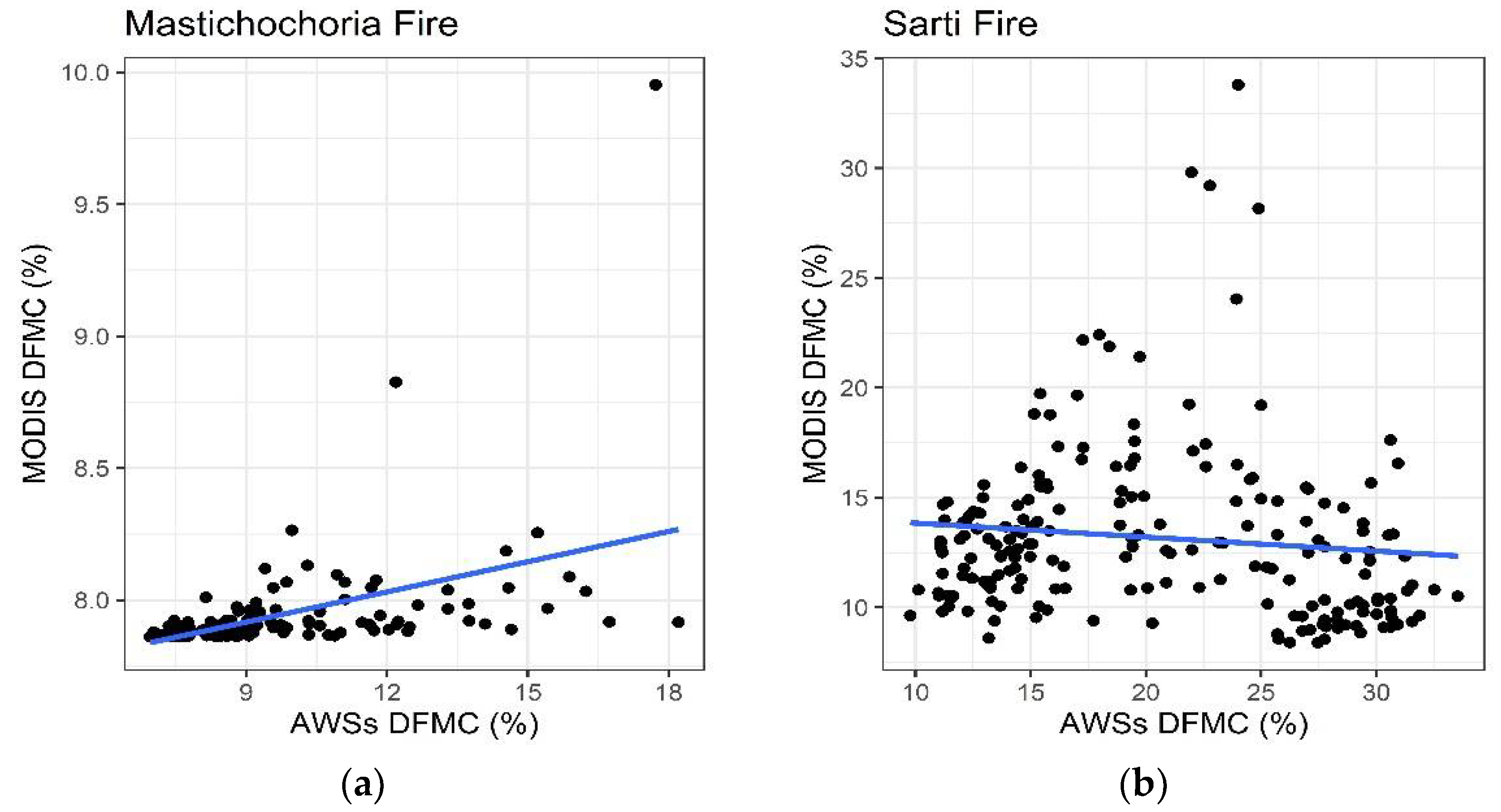

| Dataset | Location Name | Region | Area (ha) | Pre-Fire Date | Start Date | End Date | Post-Fire Date |
|---|---|---|---|---|---|---|---|
| Set 1 | Mastichochoria | Chios | 4343 | 24/07/2016 | 25/07/2016 | 26/07/2016 | 27/07/2016 |
| Farakla | Euboea | 2565 | 29/07/2016 | 30/07/2016 | 01/08/2016 | 02/08/2016 | |
| Kalamos | Attica | 2889 | 12/08/2017 | 13/08/2017 | 15/08/2017 | 16/08/2017 | |
| Anafonitria | Zakynthos | 1387 | 25/08/2017 | 26/08/2017 | 28/08/2017 | 29/08/2017 | |
| Kineta 2 | Attica | 5428 | 22/07/2018 | 23/07/2018 | 26/07/2018 | 27/07/2018 | |
| Mati 1 | Attica | 1276 | 22/07/2018 | 23/07/2018 | 24/07/2018 | 25/07/2018 | |
| Kontodespoti | Euboea | 557 | 11/08/2018 | 12/08/2018 | 13/08/2018 | 14/08/2018 | |
| Sarti | Chalkidiki | 675 | 24/10/2018 | 25/10/2018 | 26/10/2018 | 27/10/2018 | |
| Elafonisos | Lakonia | 535 | 09/08/2019 | 10/08/2019 | 11/08/2019 | 12/08/2019 | |
| Kontodespoti | Euboea | 2889 | 12/08/2019 | 13/08/2019 | 14/08/2019 | 15/08/2019 | |
| Loutraki | Attica | 352 | 13/09/2019 | 14/09/2019 | 15/09/2019 | 16/09/2019 | |
| Lithakia | Zakynthos | 919 | 14/09/2019 | 15/09/2019 | 16/09/2019 | 17/09/2019 | |
| Set 2 | Kechries 3 | Corinthia | 3549 | 21/07/2020 | 22/07/2020 | 23/07/2020 | 24/07/2020 |
| Lagada 4 | Mani | 1894 | 21/08/2020 | 22/08/2020 | 23/08/2020 | 24/08/2020 |
| Study Areas | Data | MODIS Tiles | Total Number of Tiles | Level of Analysis | Spatial Resolution |
|---|---|---|---|---|---|
| Set 1 | MOD11A1 | One Tile per date (LSTTILE) 1 | 49 | regional Level | 1000 × 1000 km |
| Set 2 | MOD11A1 | Four Tiles per date (LST4-TILES) 2 | 40 | Country level | 1000 × 1000 km |
| Set 1 & Set 2 | Weather Data | - | Country level |
| Dataset | FM0 | FM1 | m |
|---|---|---|---|
| Satellite Data (MOD11A1) | 7.86 | 140.94 | 3.73 |
| Meteorological Data | 6.79 | 27.43 | 1.05 |
| Variable MODIS D | MBE (kPa) | MAE (kPa) | RMSE (kPa) |
|---|---|---|---|
| Anafonitria | −0.87 | 1.02 | 1.23 |
| Elafonissos | −1.19 | 1.26 | 1.48 |
| Farakla | −0.89 | 0.98 | 1.17 |
| Kalamos | −0.68 | 0.83 | 1.03 |
| Kineta and Mati | −0.98 | 1.16 | 1.54 |
| Kontodespoti 2018 | −0.41 | 0.61 | 0.75 |
| Kontodespoti 2019 | −0.69 | 0.90 | 1.14 |
| Lithakia | −0.62 | 0.80 | 0.94 |
| Loutraki | −0.65 | 0.78 | 0.93 |
| Mastichochoria | −0.22 | 0.59 | 0.76 |
| Sarti | 0.14 | 0.52 | 0.62 |
| Variable MODIS DFMC | MBE (%) | MAE (%) | RMSE (%) |
|---|---|---|---|
| Anafonnitria | −1.21 | 1.75 | 3.92 |
| Elafonissos | −0.19 | 0.97 | 1.63 |
| Farakla | −0.29 | 0.95 | 2.03 |
| Kalamos | −0.91 | 1.39 | 2.83 |
| Kineta and Mati | −0.90 | 1.59 | 2.60 |
| Kontodespoti 2018 | −1.63 | 1.81 | 3.66 |
| Kontodespoti 2019 | −0.75 | 1.30 | 2.33 |
| Lithakia | −1.94 | 2.18 | 4.87 |
| Loutraki | −1.74 | 1.98 | 4.32 |
| Mastichochoria | −1.70 | 1.96 | 2.93 |
| Sarti | −7.29 | 8.23 | 10.99 |
| Fire Event | Max MODIS DFMC | Max AWSs DFMC |
|---|---|---|
| Anafonitria | 8.24% | 9.33% |
| Elafonissos | 8.02% | 7.82% |
| Farakla | 8.07% | 8.44% |
| Kalamos | 7.96% | 9.93% |
| Mati | 7.89% | 12.67% |
| Kineta | 8.19% | 9.79% |
| Kontodespoti 2018 | 8.02% | 9.65% |
| Kontodespoti 2019 | 8.23% | 9.16% |
| Lithakia | 8.06% | 9.79% |
| Loutraki | 9.02% | 9.15% |
| Mastichochoria | 7.92% | 8.13% |
| Sarti | 15.08% | 19.23% |
Publisher’s Note: MDPI stays neutral with regard to jurisdictional claims in published maps and institutional affiliations. |
© 2021 by the authors. Licensee MDPI, Basel, Switzerland. This article is an open access article distributed under the terms and conditions of the Creative Commons Attribution (CC BY) license (https://creativecommons.org/licenses/by/4.0/).
Share and Cite
Dragozi, E.; Giannaros, T.M.; Kotroni, V.; Lagouvardos, K.; Koletsis, I. Dead Fuel Moisture Content (DFMC) Estimation Using MODIS and Meteorological Data: The Case of Greece. Remote Sens. 2021, 13, 4224. https://doi.org/10.3390/rs13214224
Dragozi E, Giannaros TM, Kotroni V, Lagouvardos K, Koletsis I. Dead Fuel Moisture Content (DFMC) Estimation Using MODIS and Meteorological Data: The Case of Greece. Remote Sensing. 2021; 13(21):4224. https://doi.org/10.3390/rs13214224
Chicago/Turabian StyleDragozi, Eleni, Theodore M. Giannaros, Vasiliki Kotroni, Konstantinos Lagouvardos, and Ioannis Koletsis. 2021. "Dead Fuel Moisture Content (DFMC) Estimation Using MODIS and Meteorological Data: The Case of Greece" Remote Sensing 13, no. 21: 4224. https://doi.org/10.3390/rs13214224









